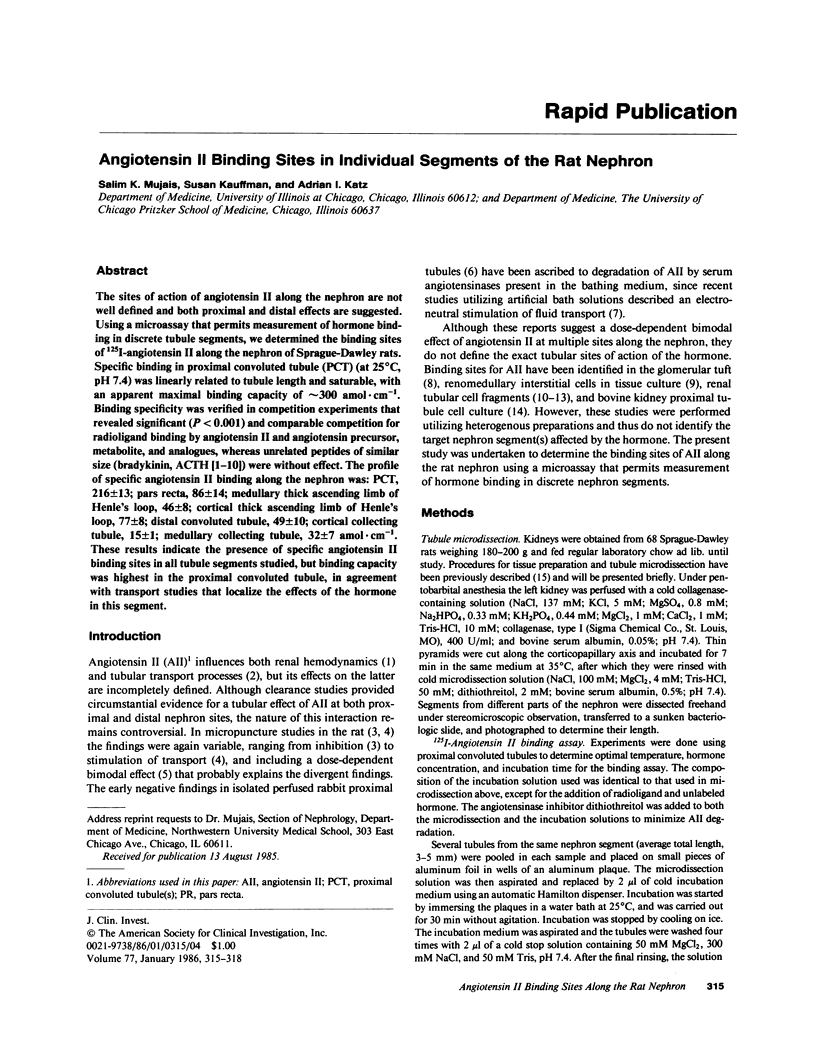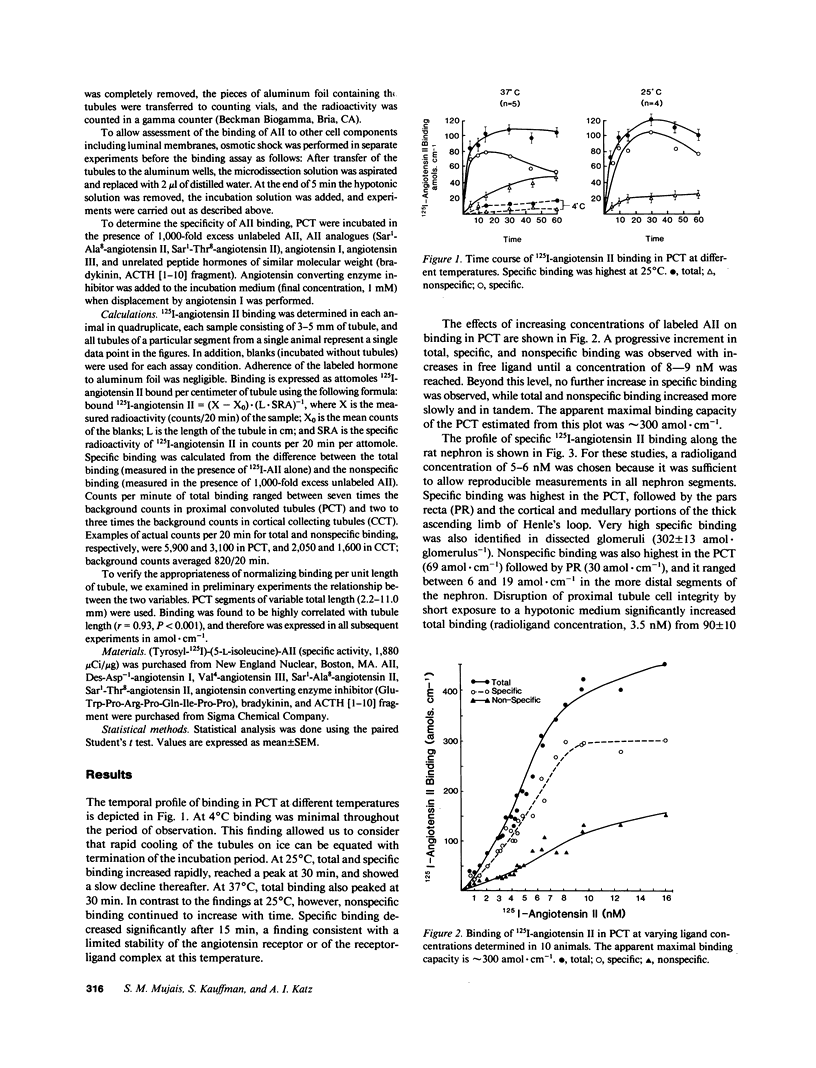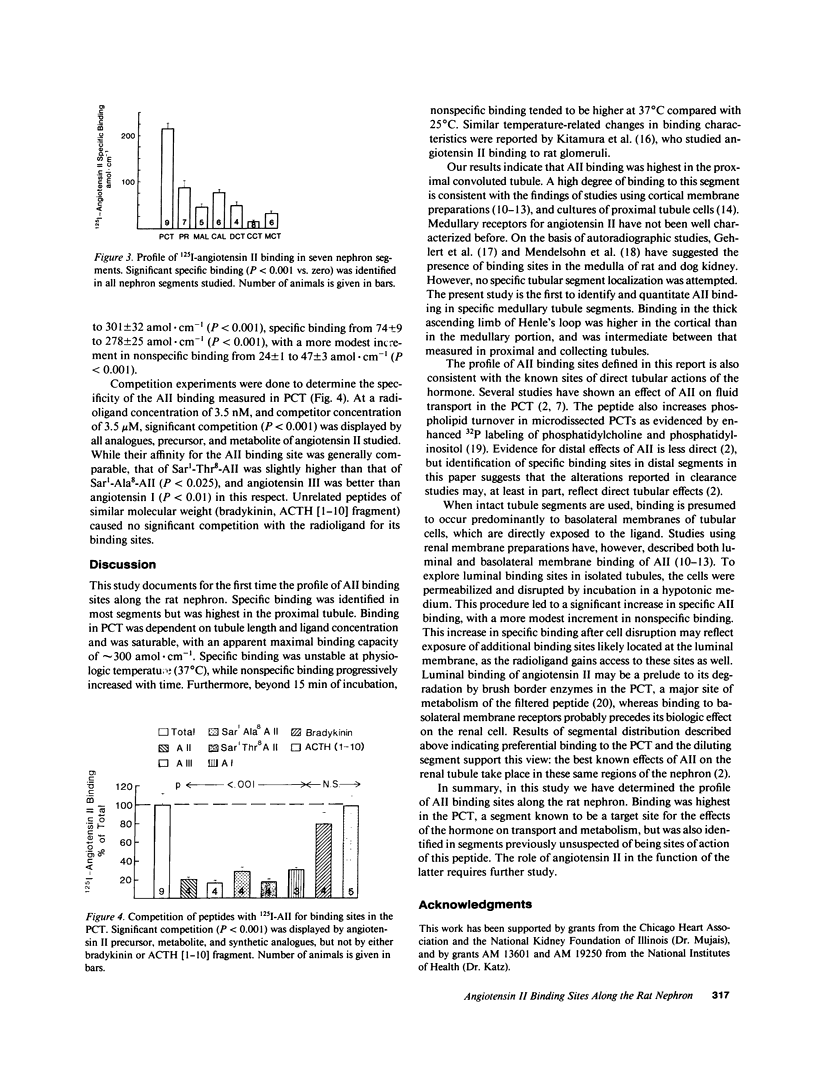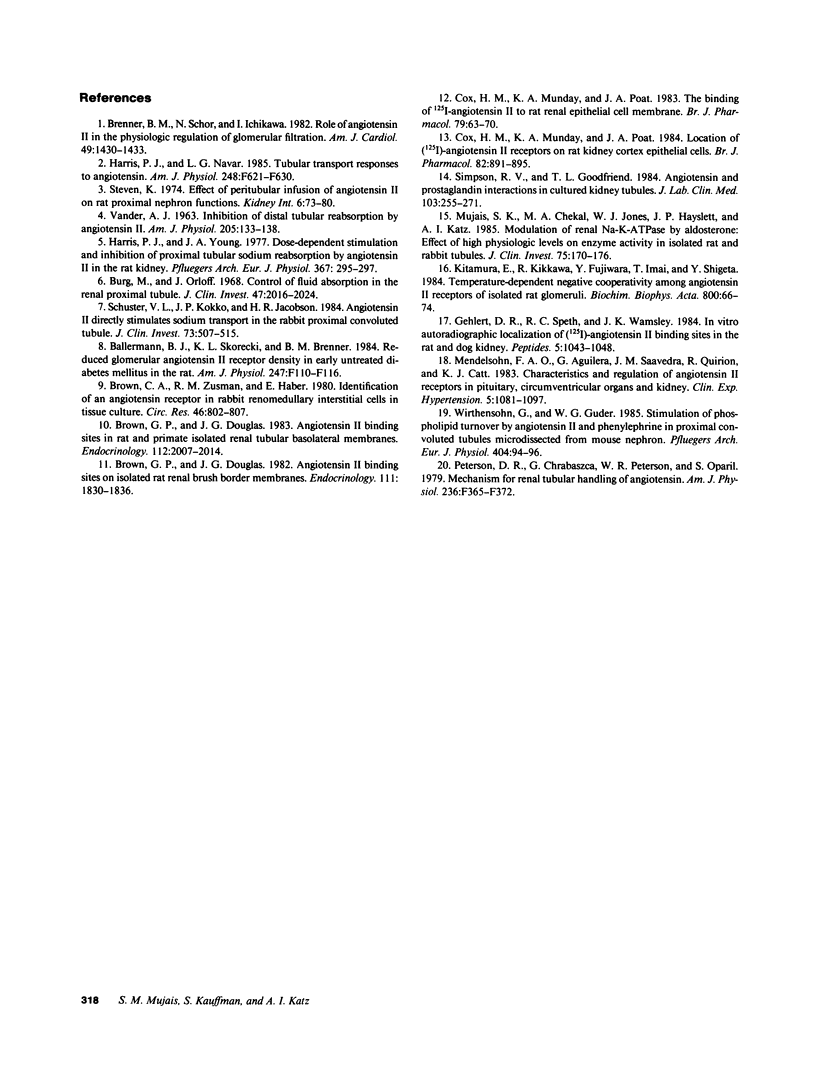Abstract
The sites of action of angiotensin II along the nephron are not well defined and both proximal and distal effects are suggested. Using a microassay that permits measurement of hormone binding in discrete tubule segments, we determined the binding sites of 125I-angiotensin II along the nephron of Sprague-Dawley rats. Specific binding in proximal convoluted tubule (PCT) (at 25 degrees C, pH 7.4) was linearly related to tubule length and saturable, with an apparent maximal binding capacity of approximately 300 amol X cm-1. Binding specificity was verified in competition experiments that revealed significant (P less than 0.001) and comparable competition for radioligand binding by angiotensin II and angiotensin precursor, metabolite, and analogues, whereas unrelated peptides of similar size (bradykinin, ACTH [1-10]) were without effect. The profile of specific angiotensin II binding along the nephron was: PCT, 216 +/- 13; pars recta, 86 +/- 14; medullary thick ascending limb of Henle's loop, 46 +/- 8; cortical thick ascending limb of Henle's loop, 77 +/- 8; distal convoluted tubule, 49 +/- 10; cortical collecting tubule, 15 +/- 1; medullary collecting tubule, 32 +/- 7 amol X cm-1. These results indicate the presence of specific angiotensin II binding sites in all tubule segments studied, but binding capacity was highest in the proximal convoluted tubule, in agreement with transport studies that localize the effects of the hormone in this segment.
Full text
PDF



Images in this article
Selected References
These references are in PubMed. This may not be the complete list of references from this article.
- Brenner B. M., Schor N., Ichikawa I. Role of angiotensin II in the physiologic regulation of glomerular filtration. Am J Cardiol. 1982 Apr 21;49(6):1430–1433. doi: 10.1016/0002-9149(82)90356-3. [DOI] [PubMed] [Google Scholar]
- Brown C. A., Zusman R. M., Haber E. Identification of an angiotensin receptor in rabbit renomedullary interstitial cells in tissue culture. Correlation with prostaglandin biosynthesis. Circ Res. 1980 Jun;46(6):802–807. doi: 10.1161/01.res.46.6.802. [DOI] [PubMed] [Google Scholar]
- Brown G. P., Douglas J. G. Angiotensin II binding sites on isolated rat renal brush border membranes. Endocrinology. 1982 Dec;111(6):1830–1836. doi: 10.1210/endo-111-6-1830. [DOI] [PubMed] [Google Scholar]
- Brown G. P., Douglas J. G. Angiotensin II-binding sites in rat and primate isolated renal tubular basolateral membranes. Endocrinology. 1983 Jun;112(6):2007–2014. doi: 10.1210/endo-112-6-2007. [DOI] [PubMed] [Google Scholar]
- Burg M. B., Orloff J. Control of fluid absorption in the renal proximal tubule. J Clin Invest. 1968 Sep;47(9):2016–2024. doi: 10.1172/JCI105888. [DOI] [PMC free article] [PubMed] [Google Scholar]
- Cox H. M., Munday K. A., Poat J. A. Location of [125I]-angiotensin II receptors on rat kidney cortex epithelial cells. Br J Pharmacol. 1984 Aug;82(4):891–895. doi: 10.1111/j.1476-5381.1984.tb16487.x. [DOI] [PMC free article] [PubMed] [Google Scholar]
- Cox H. M., Munday K. A., Poat J. A. The binding of [125I]-angiotensin to rat renal epithelial cell membranes. Br J Pharmacol. 1983 May;79(1):63–70. doi: 10.1111/j.1476-5381.1983.tb10496.x. [DOI] [PMC free article] [PubMed] [Google Scholar]
- Gehlert D. R., Speth R. C., Wamsley J. K. In vitro autoradiographic localization of [125I]-angiotensin II binding sites in the rat and dog kidney. Peptides. 1984 Nov-Dec;5(6):1043–1048. doi: 10.1016/0196-9781(84)90168-2. [DOI] [PubMed] [Google Scholar]
- Harris P. J., Navar L. G. Tubular transport responses to angiotensin. Am J Physiol. 1985 May;248(5 Pt 2):F621–F630. doi: 10.1152/ajprenal.1985.248.5.F621. [DOI] [PubMed] [Google Scholar]
- Harris P. J., Young J. A. Dose-dependent stimulation and inhibition of proximal tubular sodium reabsorption by angiotensin II in the rat kidney. Pflugers Arch. 1977 Jan 17;367(3):295–297. doi: 10.1007/BF00581370. [DOI] [PubMed] [Google Scholar]
- Kitamura E., Kikkawa R., Fujiwara Y., Imai T., Shigeta Y. Temperature-dependent negative cooperativity among angiotensin II receptors of isolated rat glomeruli. Biochim Biophys Acta. 1984 Jul 16;800(1):66–74. doi: 10.1016/0304-4165(84)90095-3. [DOI] [PubMed] [Google Scholar]
- Mendelsohn F. A., Aguilera G., Saavedra J. M., Quirion R., Catt K. J. Characteristics and regulation of angiotensin II receptors in pituitary, circumventricular organs and kidney. Clin Exp Hypertens A. 1983;5(7-8):1081–1097. doi: 10.3109/10641968309048843. [DOI] [PubMed] [Google Scholar]
- Mujais S. K., Chekal M. A., Jones W. J., Hayslett J. P., Katz A. I. Modulation of renal sodium-potassium-adenosine triphosphatase by aldosterone. Effect of high physiologic levels on enzyme activity in isolated rat and rabbit tubules. J Clin Invest. 1985 Jul;76(1):170–176. doi: 10.1172/JCI111942. [DOI] [PMC free article] [PubMed] [Google Scholar]
- Peterson D. R., Chrabaszcz G., Peterson W. R., Oparil S. Mechanism for renal tubular handling of angiotensin. Am J Physiol. 1979 Apr;236(4):F365–F372. doi: 10.1152/ajprenal.1979.236.4.F365. [DOI] [PubMed] [Google Scholar]
- Schuster V. L., Kokko J. P., Jacobson H. R. Angiotensin II directly stimulates sodium transport in rabbit proximal convoluted tubules. J Clin Invest. 1984 Feb;73(2):507–515. doi: 10.1172/JCI111237. [DOI] [PMC free article] [PubMed] [Google Scholar]
- Simpson R. U., Goodfriend T. L. Angiotensin and prostaglandin interactions in cultured kidney tubules. J Lab Clin Med. 1984 Feb;103(2):255–271. [PubMed] [Google Scholar]
- Steven K. Effect of peritubular infusion of angiotensin II on rat proximal nephron function. Kidney Int. 1974 Aug;6(2):73–80. doi: 10.1038/ki.1974.82. [DOI] [PubMed] [Google Scholar]
- VANDER A. J. Inhibition of distal tubular sodium reabsorption by angiotensin. II. Am J Physiol. 1963 Jul;205:133–138. doi: 10.1152/ajplegacy.1963.205.1.133. [DOI] [PubMed] [Google Scholar]
- Wirthensohn G., Guder W. G. Stimulation of phospholipid turnover by angiotensin II and phenylephrine in proximal convoluted tubules microdissected from mouse nephron. Pflugers Arch. 1985 May;404(1):94–96. doi: 10.1007/BF00581500. [DOI] [PubMed] [Google Scholar]



